As our winters have warmed, the summer vegetables have produced later in the season, while tomatoes and eggplants have survived and have supplied a useful harvest through the winter months. They eventually die but we have plants still producing that were started from seed more than a year ago. Broccoli has also proven itself a plant of unexpected longevity, but this has nothing to do with the climate. We’ve simply learned that with the right kind of pruning, even senescent plants can be kept productive.
We discovered this phenomenon a couple of years ago when the rabbits, which normally ignore our vegetables, seemingly preferring the lawn, began aggressively attacking some of our edibles. We were fairly successful in protecting our seedlings by surrounding them with insect barrier netting, as I described in a previous article (Dec 2020), but I left in the ground some old broccoli plants that I normally would have pulled, hoping they would divert the bunnies from our more desirable plantings. They certainly did snack regularly on the broccoli, though it’s hard to say whether this ‘appeasement policy’ was any more successful than Chamberlain’s. What we did see was that the new growths sprouting from the base and from the roots of the old plants were kept nicely trimmed, while the larger stems at the centre were unmolested.
Ordinarily we pull up the plants when they begin to put up a multitude of side shoots with florets too small to be worth harvesting. This year we found the old plant occasionally forming florets up to a couple of inches in diameter and a greater number that were smaller but still of a size worth cutting. The four plants that we left in place produced enough for an occasional meal. During the warmest days of what was an unusually cool summer the individual buds were a bit thin and dry but fresh cut they were of acceptable quality. As the weather cooled in late September, the buds became plumper, and we found ourselves enjoying broccoli two or three times a week with some to give away. As I write in the last week of November the new plants, started from seed in late August, are still a week or so short of being ready for harvest. I probably won’t consider digging up the old plants at least until the new year, especially because this year’s second planting was hit by rabbits when I forgot to replace the hot caps after fertilizing them.
As I explained in a previous article, you need to prune the old plants aggressively if you want them to continue producing florets of a size worth harvesting. All spindly new growth from the roots or the trunks of the old plants must be ripped out. When you do cut a floret, the growth bearing it should be cut back to a stem at least an inch in diameter. After you’ve done this for a while you’ll get a feel for which new shoots are likely to mature to a good head and which should be sacrificed before they split into many tiny florets.
